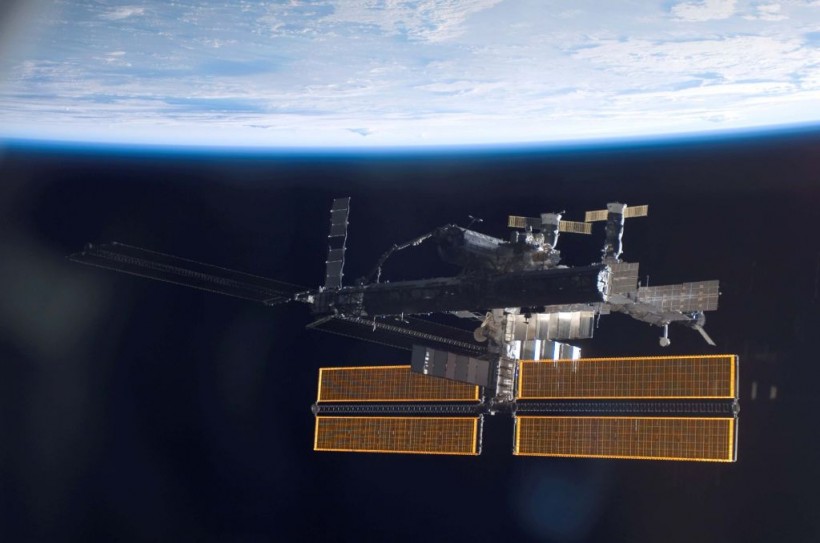The International Space Station (ISS) is not a "station" because it remains stationary in orbit but moves in time with the Earth's rotation and revolution around the Sun.
That said, it's that time of year when the International Space Station will be visible from Earth without the appropriate equipment and appear in many locations.
While this may appear to be a spectacular sight, NASA said ISS orbits the Earth every 90 minutes, viewing it many times during the day. However, because seeing the space station with the naked eye is nearly impossible during the day, time is crucial.

IN SPACE - SEPTEMBER 17: In this handout photo provided by NASA, This view of the International Space Station over a blue and white Earth was taken shortly after the Space Shuttle Atlantis undocked from the orbital outpost at 7:50 a.m. CDT. The unlinking completed six days, two hours and two minutes of joint operations with the station crew. Atlantis left the station with a new, second pair of 240-foot solar wings, attached to a new 17.5-ton section of truss with batteries, electronics and a giant rotating joint. The new solar arrays eventually will double the station's onboard power when their electrical systems are brought online during the next shuttle flight, planned for launch in December.
International Space Station Transits Across Moon As Seen From Florida
Michael Seeley, the co-founder of We Report Space, which covers aerospace events and photos of rocket launches, uploaded a shot of the International Space Station transiting across the Moon from Fort Pierce, Florida, on Wednesday at 9:53 p.m. (EST).
Seeley stated in his Twitter post that the space station was traveling at a speed of 28,163 kilometers per hour and that the composite image of the transit took a little over half a second.
This is the @Space_Station and crew of 7 astronauts passing in front of the Moon seen Wednesday at 9:53pm from Fort Pierce, Florida.
— Michael Seeley (@Mike_Seeley) May 12, 2022
It's fast, traveling at ~17,500 mph. The transit shown (in a composite series) took just over a half a second. #SpotTheStation pic.twitter.com/luEB2XCDrp
Spacewalk Seen From Earth
Republic World said this isn't the first time astrophotographers have seen the ISS from Earth.
An astrophotographer uploaded a photograph of two astronauts on a spacewalk taken from the ground earlier this year and the snap went viral on Twitter.
Yesterday I witnessed the #spacewalk shortly after sunset. Here comes a first photo. #ESA #astronaut Matthias Maurer was just "climbing" at this moment.
The rod-shaped structure (Canadarm2) is the robot arm.
Greetings from Matthias Maurers hometown - it was very exciting. #iss pic.twitter.com/39Q7YlG64u— Dr. Sebastian Voltmer (@SeVoSpace) March 24, 2022
Science Alert said Sebastian Voltmer is an award-winning German photographer whose work has appeared in Sky, Telescope, and other magazines. His astrophotography has been shown at the Smithsonian Institution in Washington, DC, the Carl Zeiss Planetarium in Stuttgart, and several other venues.
On March 23, Voltmer captured the photograph. It depicts American astronaut Raja Chari and German astronaut Matthias Maurer doing a six-hour spacewalk to install a camera and perform maintenance and upgrades.
"I used a C11 EdgeHD telescope on a 10micron GM 2000 HPS mount. One day before the ISS pass I updated my mount with the recent coordinates of the space station," he told PetaPixel. "With my servo motors I was able to track the really fast ISS."
How to See ISS From Earth
Not everyone has the same time or geographic location, so relying on a certain area's timetable would not ensure seeing the ISS. It's a good thing NASA built a technology to identify the ISS directly at home or wherever you are, and all you have to do is locate a certain position for NASA to set the space station's schedule and location.
The space station, which spans the length of a football field, is the biggest spaceship in orbit and is powered by an acre of solar panels that reflect sunlight. It may frequently be seen zooming across the night sky. Online resources like spotthestation.nasa.gov can help you determine when and how to see the space station.
RELATED ARTICLE: Solar Flare Warning: Incoming Geomagnetic Storm Could Harm Astronauts on the ISS, Knock Down Power Systems and Distort Signals on Earth
Check out more news and information on Space in Science Times.














